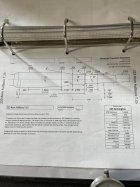Well, it's cold out so I'm bouncing a couple of things that I've been considering for a while off of the vast knowledge base on here.
Right now I'm thinking about the area of the chamber between where the case ends and the throat begins. It's that 45° area at the end of the case mouth of the chamber.
Just thinking here and again, wondering if others have tried it or just what your thoughts on this are.
Any point like this that is fairly abrupt or has sharp angle changes becomes a heat sink area. We almost all have a borescope of some type these days and it's pretty clear that firecracking begins right there...and it makes sense that it would. Lets focus on this area for a minute. Exact neck diameter can affect the exact numbers but you'll get my thinking pretty fast, I think. In a pretty typical, say .272 6mm neck chamber, this 45° bevel is about .015 long..so it's short and abrupt, right?
I understand that very short freebores won't always work here but lets say we make that area 15° instead of the standard 45°. So, instead of it being about .015 long, it's now about .045 long, so you have to have at least that much freebore before you can even really consider this.
Bottom line, we've smoothed that heat sink down a lot. Will that help bbl life and will it affect accuracy in the short term? Logically, I see no reason accuracy should change either way but I see a very big potential for increasing useful barrel life.
Years ago, when Smith came out with their then new 500S&W revolver, they had pretty significant issues with flame cutting of the top strap portion of the frame. One of their engineers told me how they fixed it and it WORKED....they polished the inside of the top strap!! No rough edges to serve as a heat sink. The flame traveled smoothly over the smooth surface and didn't cut into rough areas, proliferating the whole issue as it grew and grew. I look at barrel break in pretty much the same way but that's a different subject.
So what are your thoughts. I think it has huge potential in regard to bbl life without any negative aspects as long as you have enough freebore in the given chamber design/bullet length etc. Maybe this should go in the gunsmithing forum but I'm mostly interested in competition gunsmith and shooters' opinions. Fire away. I think it's worth discussing unless someone that's done it can shoot it down. Thanks!--Mike
Right now I'm thinking about the area of the chamber between where the case ends and the throat begins. It's that 45° area at the end of the case mouth of the chamber.
Just thinking here and again, wondering if others have tried it or just what your thoughts on this are.
Any point like this that is fairly abrupt or has sharp angle changes becomes a heat sink area. We almost all have a borescope of some type these days and it's pretty clear that firecracking begins right there...and it makes sense that it would. Lets focus on this area for a minute. Exact neck diameter can affect the exact numbers but you'll get my thinking pretty fast, I think. In a pretty typical, say .272 6mm neck chamber, this 45° bevel is about .015 long..so it's short and abrupt, right?
I understand that very short freebores won't always work here but lets say we make that area 15° instead of the standard 45°. So, instead of it being about .015 long, it's now about .045 long, so you have to have at least that much freebore before you can even really consider this.
Bottom line, we've smoothed that heat sink down a lot. Will that help bbl life and will it affect accuracy in the short term? Logically, I see no reason accuracy should change either way but I see a very big potential for increasing useful barrel life.
Years ago, when Smith came out with their then new 500S&W revolver, they had pretty significant issues with flame cutting of the top strap portion of the frame. One of their engineers told me how they fixed it and it WORKED....they polished the inside of the top strap!! No rough edges to serve as a heat sink. The flame traveled smoothly over the smooth surface and didn't cut into rough areas, proliferating the whole issue as it grew and grew. I look at barrel break in pretty much the same way but that's a different subject.
So what are your thoughts. I think it has huge potential in regard to bbl life without any negative aspects as long as you have enough freebore in the given chamber design/bullet length etc. Maybe this should go in the gunsmithing forum but I'm mostly interested in competition gunsmith and shooters' opinions. Fire away. I think it's worth discussing unless someone that's done it can shoot it down. Thanks!--Mike











